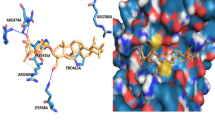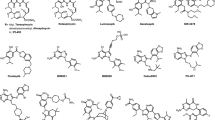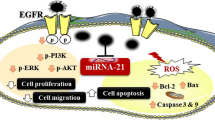Abstract
Purpose
Heat shock protein 90 (Hsp90) is a conserved chaperone involved in crucial signaling events in normal and malignant cells. Previous research suggests that tumor cells are particularly dependent on Hsp90 for survival as well as malignant progression. Hsp90 inhibitors which are derivates of the natural compound geldanamycin, such as the orally bioavailable 17-(dimethylaminoethylamino)-17-demethoxygeldanamycin (17-DMAG), are currently being tested in clinical trials and small molecule inhibitors are in development. In this study we investigated the response of a panel of cervical carcinoma cell lines in vitro and in vivo to determine potential factors that might influence the sensitivity towards Hsp90 inhibition.
Methods
Cell viability, proliferation and drug-induced changes on Hsp90 chaperoned “client” factors were examined with focus on G2/M cell cycle regulators, and a comparison with immortalized and normal keratinocytes was performed. ME180 and CaSki cells were grown as subcutaneous xenografts in mice treated with 6–10 mg/kg 17-DMAG by oral gavage 2×/day on a chronic schedule. Tissue concentrations of 17-DMAG were measured by high performance liquid chromatography.
Results
Cell death during abnormal mitosis was observed within 48 h after treatment start. ME180 and CaSki showed more cell death at this time point than SiHa and HeLa, and higher levels of pre-treatment Akt activity. IC50 values ranged between 17 and 37 nanoM geldanamycin (MTS). Keratinocytes were at least as sensitive as carcinoma cells. All cell lines responded with an increase of the G2/M fraction. Despite in vitro effectiveness and tissue concentrations of 1 µM, only a limited tumor growth reduction was observed with 17-DMAG given close to the maximum tolerated dose level. Lower levels of Hsp90 protein, a lower Akt activity and signs of tissue hypoxia were observed in xenografts compared to cell cultures.
Conclusions
We show here that Hsp90 inhibition effectively induces apoptosis and growth arrest in cervical carcinoma cells in vitro. Mitotic catastrophe was identified as one mechanism of cell death. In contrast, a limited efficacy of 17-DMAG was observed in subcutaneous xenograft models. Induction of a heat shock response has previously been implicated in resistance towards Hsp90 inhibition. Additional factors might be (1) an altered abundance and/or activity of primary (Hsp90) and secondary (e.g., Akt) target(s), (2) a narrow therapeutic range of 17-DMAG by oral application and (3) response-modifying factors within the tumor environment. The further development of synthetic Hsp90 inhibitors with increased therapeutic window is warranted.






Similar content being viewed by others
References
Pratt WB, Toft DO (2003) Regulation of signaling protein function and trafficking by the hsp90/hsp70-based chaperone machinery. Exp Biol Med (Maywood) 228:111–133
Kamal A, Thao L, Sensintaffar J, Zhang L, Boehm MF, Fritz LC, Burrows FJ (2003) A high-affinity conformation of Hsp90 confers tumour selectivity on Hsp90 inhibitors. Nature 425:407–410
BeBoer C, Dietz A (1976) The description and antibiotic production of Streptomyces hygroscopicus var. Geldanus. J Antibiotics (Tokyo) 29:1182–1188
Whitesell L, Mimnaugh EG, De Costa B, Myers CE, Neckers LM (1994) Inhibition of heat shock protein HSP90-pp60v-src heteroprotein complex formation by benzoquinone ansamycins: essential role for stress proteins in oncogenic transformation. Proc Natl Acad Sci USA 91:8324–8328
Dutta R, Inouye M (2000) GHKL, an emergent ATPase/kinase superfamily. Trends Biochem Sci 25:24–28
Pacey S, Banerji U, Judson I, Workman P (2006) Hsp90 inhibitors in the clinic. Handbook Exp Pharmacol 172:331–358
Egorin MJ, Lagattuta TF, Hamburger DR, Covey JM, White KD, Musser SM, Eiseman JL (2002) Pharmacokinetics, tissue distribution, and metabolism of 17-(dimethylaminoethylamino)-17-demethoxygeldanamycin (NSC 707545) in CD2F1 mice and Fischer 344 rats. Cancer Chemother Pharmacol 49:7–19
Eiseman JL, Lan J, Lagattuta TF, Hamburger DR, Joseph E, Covey JM, Egorin MJ (2005) Pharmacokinetics and pharmacodynamics of 17-demethoxy 17-[[(2-dimethylamino)ethyl]amino]geldanamycin (17DMAG, NSC 707545) in C.B-17 SCID mice bearing MDA-MB-231 human breast cancer xenografts. Cancer Chemother Pharmacol 55:21–32
Hollingshead M, Alley M, Burger AM, Borgel S, Pacula-Cox C, Fiebig HH, Sausville EA (2005) In vivo antitumor efficacy of 17-DMAG (17-dimethylaminoethylamino-17-demethoxygeldanamycin hydrochloride), a water-soluble geldanamycin derivative. Cancer Chemother Pharmacol 56:115–125
Glaze ER, Lambert AL, Smith AC, Page JG, Johnson WD, McCormick DL, Brown AP, Levine BS, Covey JM, Egorin MJ, Eiseman JL, Holleran JL, Sausville EA, Tomaszewski JE (2005) Preclinical toxicity of a geldanamycin analog, 17-(dimethylaminoethylamino)-17-demethoxygeldanamycin (17-DMAG), in rats and dogs: potential clinical relevance. Cancer Chemother Pharmacol 56:637–647
Shadad FN, Ramanathan RK (2006) 17-dimethylaminoethylamino-17-demethoxygeldanamycin in patients with advanced-stage solid tumors and lymphoma: a phase I study. Clin Lymphoma Myeloma 6:500–501
Zhang L, Fan J, Vu K, Hong K, Le Brazidec JY, Shi J, Biamonte M, Busch DJ, Lough RE, Grecko R, Ran Y, Sensintaffar JL, Kamal A, Lundgren K, Burrows FJ, Mansfield R, Timony GA, Ulm EH, Kasibhatla SR, Boehm MF (2006) 7′-substituted benzothiazolothio- and pyridinothiazolothio-purines as potent heat shock protein 90 inhibitors. J Med Chem 49:5352–5362
Parkin DM, Bray F (2006) Chapter 2: The burden of HPV-related cancers. Vaccine 24(Suppl 3):S11–S25
Walboomers JM, Jacobs MV, Manos MM, Bosch FX, Kummer JA, Shah KV, Snijders PJ, Peto J, Meijer CJ, Munoz N (1999) Human papillomavirus is a necessary cause of invasive cervical cancer worldwide. J Pathol 189:12–19
Soutter WP, Sasieni P, Panoskaltsis T (2006) Long-term risk of invasive cervical cancer after treatment of squamous cervical intraepithelial neoplasia. Int J Cancer 118:2048–2055
Yuan C, Wang P, Lai C, Tsu E, Yen M, Ng H (1999) Recurrence and survival analyses of 1,115 cervical cancer patients treated with radical hysterectomy. Gynecol Obstet Invest 47:127–132
Whitesell L, Lindquist SL (2005) HSP90 and the chaperoning of cancer. Nat Rev Cancer 5: 761–772
Bagatell R, Paine-Murrieta GD, Taylor CW, Pulcini EJ, Akinaga S, Benjamin IJ, Whitesell L (2000) Induction of a heat shock factor 1-dependent stress response alters the cytotoxic activity of hsp90-binding agents. Clin Cancer Res 6:3312–3318
Guo F, Rocha K, Bali P, Pranpat M, Fiskus W, Boyapalle S, Kumaraswamy S, Balasis M, Greedy B, Armitage ES, Lawrence N, Bhalla K (2005) Abrogation of heat shock protein 70 induction as a strategy to increase antileukemia activity of heat shock protein 90 inhibitor 17-allylamino-demethoxy geldanamycin. Cancer Res 65:10536–10544
McCollum AK, Teneyck CJ, Sauer BM, Toft DO, Erlichman C (2006) Up-regulation of heat shock protein 27 induces resistance to 17-allylamino-demethoxygeldanamycin through a glutathione-mediated mechanism. Cancer Res 66:10967–10975
Schwock J, Geddie WR, Hedley DW (2005) Analysis of hypoxia-inducible factor-1alpha accumulation and cell cycle in geldanamycin-treated human cervical carcinoma cells by laser scanning cytometry. Cytometry A 68:59–70
Pham NA, Gal MR, Bagshaw RD, Mohr AJ, Chue B, Richardson T, Callahan JW (2005) A comparative study of cytoplasmic granules imaged by the real-time microscope, Nile Red and Filipin in fibroblasts from patients with lipid storage diseases. J Inherit Metab Dis 28:991–1004
Xie XY, Robb D, Chow S, Hedley DW (1995) Discordant P-glycoprotein antigen expression and transport function in acute myeloid leukemia. Leukemia 9:1882–1887
Burrows F, Zhang H, Kamal A (2004) Hsp90 activation and cell cycle regulation. Cell Cycle, 3:1530–1536
de Carcer G (2004) Heat shock protein 90 regulates the metaphase–anaphase transition in a polo-like kinase-dependent manner. Cancer Res 64:5106–5112
Okumura E, Fukuhara T, Yoshida H, Hanada Si S, Kozutsumi R, Mori M, Tachibana K, Kishimoto T (2002) Akt inhibits Myt1 in the signalling pathway that leads to meiotic G2/M-phase transition. Nat Cell Biol 4:111–116
Ibrahim NO, Hahn T, Franke C, Stiehl DP, Wirthner R, Wenger RH, Katschinski DM (2005) Induction of the hypoxia-inducible factor system by low levels of heat shock protein 90 inhibitors. Cancer Res 65:11094–11100
Hockel M, Dornhofer N (2005) The hydra phenomenon of cancer: why tumors recur locally after microscopically complete resection. Cancer Res 65:2997–3002
Castle PE, Ashfaq R, Ansari F, Muller CY (2005) Immunohistochemical evaluation of heat shock proteins in normal and preinvasive lesions of the cervix. Cancer Lett 229:245–252
Nomura M, Nomura N, Newcomb EW, Lukyanov Y, Tamasdan C, Zagzag D (2004) Geldanamycin induces mitotic catastrophe and subsequent apoptosis in human glioma cells. J Cell Physiol 201:374–384
Basto R, Gergely F, Draviam VM, Ohkura H, Liley K, Raff JW (2007) Hsp90 is required to localise cyclin B and Msps/ch-TOG to the mitotic spindle in Drosophila and humans. J Cell Sci 120:1278–1287
Franke TF, Hornik CP, Segev L, Shostak GA, Sugimoto C (2003) PI3K/Akt and apoptosis: size matters. Oncogene 22:8983–8998
Sato S, Fujita N, Tsuruo T (2000) Modulation of Akt kinase activity by binding to Hsp90. Proc Natl Acad Sci USA 97:10832–10837
Meares GP, Zmijewska AA, Jope RS (2004) Heat shock protein-90 dampens and directs signaling stimulated by insulin-like growth factor-1 and insulin. FEBS Lett 574:181–186
Sanderson S, Valenti M, Gowan S, Patterson L, Ahmad Z, Workman P, Eccles SA (2006) Benzoquinone ansamycin heat shock protein 90 inhibitors modulate multiple functions required for tumor angiogenesis. Mol Cancer Ther 5:522–532
Bisht KS, Bradbury CM, Mattson D, Kaushal A, Sowers A, Markovina S, Ortiz KL, Sieck LK, Isaacs JS, Brechbiel MW, Mitchell JB, Neckers LM, Gius D (2003) Geldanamycin and 17-allylamino-17-demethoxygeldanamycin potentiate the in vitro and in vivo radiation response of cervical tumor cells via the heat shock protein 90-mediated intracellular signaling and cytotoxicity. Cancer Res 63:8984–8995
Dote H, Burgan WE, Camphausen K, Tofilon PJ (2006) Inhibition of hsp90 compromises the DNA damage response to radiation. Cancer Res 66:9211–9220
Sharp S, Workman P (2006) Inhibitors of the HSP90 molecular chaperone: current status. Adv Cancer Res 95:323–348
Chaudhury S, Welch TR, Blagg BS (2006) Hsp90 as a target for drug development. ChemMedChem 1:1331–1340
Acknowledgments
17-DMAG (NSC 707545) from Kosan Biosciences was supplied by the Cancer Therapy Evaluation Program of the National Cancer Institute (Rockville, MD). We are indebted to the research team of Richardson Technologies, Inc., particularly Bruno Chue, for their support with the live-cell imaging studies and data processing. We also thank Wen-Jiang Zhang and Dr. Xueyu Chen (Ontario Cancer Institute) for the HPLC measurements performed for 17-DMAG in xenograft samples and Melania Pintilie for help with the statistical analysis of the animal data. This study was supported by the Terry Fox Program Project Grant of the National Cancer Institute of Canada. J.S. was supported by the CIHR Training Program on Clinician Scientists in Molecular Oncologic Pathology (STP-53912).
Author information
Authors and Affiliations
Corresponding author
Rights and permissions
About this article
Cite this article
Schwock, J., Pham, NA., Cao, M.P. et al. Efficacy of Hsp90 inhibition for induction of apoptosis and inhibition of growth in cervical carcinoma cells in vitro and in vivo. Cancer Chemother Pharmacol 61, 669–681 (2008). https://doi.org/10.1007/s00280-007-0522-8
Received:
Accepted:
Published:
Issue Date:
DOI: https://doi.org/10.1007/s00280-007-0522-8




